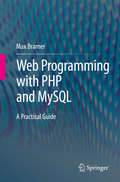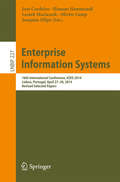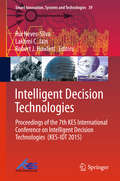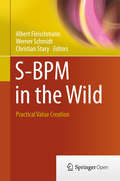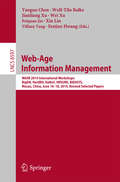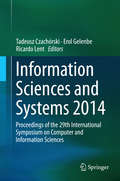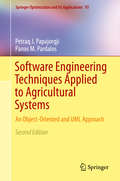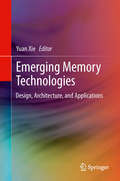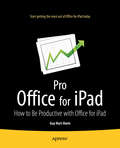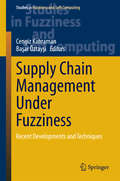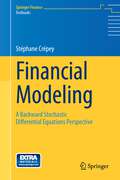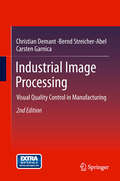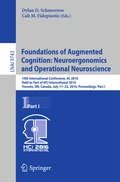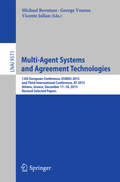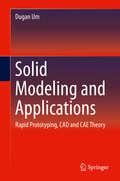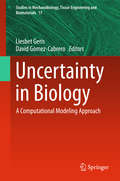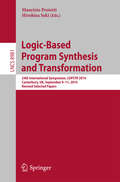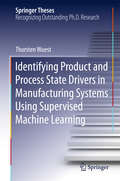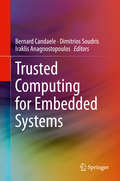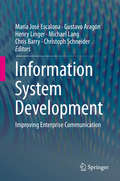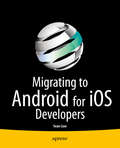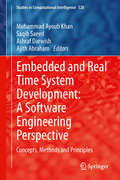- Table View
- List View
Web Programming with PHP and MySQL
by Max BramerIntroductory textbook covering all the main features of the 'web programming' languages PHP and MySQL together with detailed examples that will enable readers (whether students on a taught course or independent learners) to use them to create their own applications or understand existing ones. A particular focus is the use of PHP to generate MySQL commands from a script as it is executed. Each chapter includes aims, a summary and practical exercises (with solutions) to support learning. Chapters are designed to stand alone as far as possible, so that they can be studied independently of the rest of the text by those with some previous knowledge of the languages. There is a comprehensive glossary of technical terms, together with extensive appendices for quick reference of language features.
Enterprise Information Systems
by Joaquim Filipe Slimane Hammoudi Olivier Camp José Cordeiro Leszek MaciaszekThis book contains extended and revised papers from the 16th International Conference on Enterprise Information Systems, ICEIS 2014, held in Lisbon, Portugal, in April 2014. The 24 papers presented in this volume were carefully reviewed and selected from a total of 313 submissions. The book also contains two full-paper invited talks. The selected papers reflect state-of-the-art research that is oriented toward real-world applications and highlight the benefits of information systems and technology for industry and services. They are organized in topical sections on databases and information systems integration, artificial intelligence and decision support systems, information systems analysis and specification, software agents and Internet computing, human-computer interaction, and enterprise architecture.
Intelligent Decision Technologies
by Lakhmi C. Jain Robert J. Howlett Rui Neves-SilvaThis book presents the 57 papers accepted for presentation at the Seventh KES International Conference on Intelligent Decision Technologies (KES-IDT 2015), held in Sorrento, Italy, in June 2015. The conference consists of keynote talks, oral and poster presentations, invited sessions and workshops on the applications and theory of intelligent decision systems and related areas. The conference provides an opportunity for the presentation and discussion of interesting new research results, promoting knowledge transfer and the generation of new ideas. The book will be of interest to all those whose work involves the development and application of intelligent decision systems.
S-BPM in the Wild
by Werner Schmidt Albert Fleischmann Christian StaryThis is the first book to present field studies on the application of subject-oriented business process management (S-BPM). Each case presents a specific story and focuses on an essential modeling or implementation issue, and most end with implications or suggestions for further studies. Significant variables and success factors are identified that were discovered during the respective study and lead to suggesting S-BPM novelties. For each case, the authors explain step-by-step how the story develops, and provide readers guidance by detailing the respective rationale. The studies covered are clustered according to three main S-BPM themes: Part I "Business Operation Support" documents approaches to the practical development of S-BPM solutions in various application domains and organizational settings, while Part II "Consultancy and Education Support" highlights cases that can help to train readers in S-BPM modeling and knowledge acquisition for S-BPM lifecycle iterations. It also refers to architecting S-BPM solutions for application cases based on hands-on experience. Part III "Technical Execution Support" focuses on concepts for utilizing specific theories and technologies to execute S-BPM models. It also addresses how to create reference models for certain settings in the field. Lastly, the appendix covers all relevant aspects needed to grasp S-BPM modeling and apply it based on fundamental examples. Its format reconciles semantic precision with syntactic rigor. >Addressing the needs of developers, educators and practitioners, this book will help companies to learn from the experiences of first-time users and to develop systems that fit their business processes, explaining the latest key methodological and technological S-BPM developments in the fields of training, research and application.
Web-Age Information Management
by Wei Xu Yueguo Chen Wolf-Tilo Balke Jianliang Xu Peiquan Jin Xin Lin Tiffany Tang Eenjun HwangThis book constitutes the refereed proceedings of 5 workshops of the 15th International Conference on Web-Age Information Management, WAIM 2014, held in Macau, China, June 16-18, 2014. The 38 revised full papers are organized in topical sections on the 5 following workshops: Second International Workshop on Emergency Management in Big Data Age, BigEM 2014; Second International Workshop on Big Data Management on Emerging Hardware, HardBD 2014; International Workshop on Data Management for Next-Generation Location-based Services, DaNoS 2014; International Workshop on Human Aspects of Making Recommendations in Social Ubiquitous Networking Environment, HRSUME 2014; International Workshop on Big Data Systems and Services, BIDASYS 2014.
Information Sciences and Systems 2014
by Erol Gelenbe Ricardo Lent Tadeusz CzachórskiBased on a rigorous selection of submissions to The 29th International Symposium on Computer and Information Sciences (ISCIS 2014), this books includes some of the most recent ideas and technical results in computer systems, computer science, and computer-communication networks. It offers the reader a timely access to innovative research and advances in computing and communications from many different areas of the world. The topics covered include (but are not limited to) computer architectures and digital systems, algorithms, theory, software engineering, data engineering, computational intelligence, system security, computer systems and networks, performance modeling and analysis, distributed and parallel systems, bioinformatics, computer vision and significant applications such as medical informatics and imaging. The 29th International Symposium on Computer and Information Sciences (ISCIS 2014) took place in Krakow Old City, Poland on October, 27-8, 2014.
Software Engineering Techniques Applied to Agricultural Systems
by Panos M. Pardalos Petraq J. PapajorgjiSoftware Engineering Techniques Applied to Agricultural Systems presents cutting-edge software engineering techniques for designing and implementing better agricultural software systems based on the object-oriented paradigm and the Unified Modeling Language (UML). The focus is on the presentation of rigorous step-by-step approaches for modeling flexible agricultural and environmental systems, starting with a conceptual diagram representing elements of the system and their relationships. Furthermore, diagrams such as sequential and collaboration diagrams are used to explain the dynamic and static aspects of the software system. This second edition includes: a new chapter on Object Constraint Language (OCL), a new section dedicated to the Model-VIEW-Controller (MVC) design pattern, new chapters presenting details of two MDA-based tools - the Virtual Enterprise and Olivia Nova and a new chapter with exercises on conceptual modeling. It may be highly useful to undergraduate and graduate students as the first edition has proven to be a useful supplementary textbook for courses in mathematical programming in agriculture, ecology, information technology, agricultural operations research methods, agronomy and soil science and applied mathematical modeling. The book has broad appeal for anyone involved in software development projects in agriculture and to researchers in general who are interested in modeling complex systems. From the reviews of the first edition: "The book will be useful for those interested in gaining a quick understanding of current software development techniques and how they are applied in practice. . . this is a good introductory text on the application of OOAD, UML and design patters to the creation of agricultural systems. It is technically sound and well written. " --Computing Reviews, September 2006
Enterprise Mac Administrator's Guide
by William Smith Charles S. EdgeCharles Edge, Zack Smith, and Beau Hunter provide detailed explanations of the technology required for large-scale Mac OS X deployments and show you how to integrate it with other operating systems and applications. Enterprise Mac Administrator's Guide addresses the growing size and spread of Mac OS X deployments in corporations and institutions worldwide. In some cases, this is due to the growth of traditional Mac environments, but for the most part it has to do with switcher campaigns, where Windows and/or Linux environments are migrating to Mac OS X. However, there is a steep culture shock with these types of migrations. The products that are used are different, the nomenclature is different, and most importantly the best practices for dealing with the operating system are different. Apple provides a number of tools to help automate and guide IT toward managing a large number of Mac OS X computers-it has since before Mac OS X was initially released. However, if you want to put together all of the pieces to tell a compelling story about how to run an IT department or a deployment of Macs, you need to compile information from a number of different sources.
Emerging Memory Technologies
by Yuan XieThis book explores the design implications of emerging, non-volatile memory (NVM) technologies on future computer memory hierarchy architecture designs. Since NVM technologies combine the speed of SRAM, the density of DRAM, and the non-volatility of Flash memory, they are very attractive as the basis for future universal memories. This book provides a holistic perspective on the topic, covering modeling, design, architecture and applications. The practical information included in this book will enable designers to exploit emerging memory technologies to improve significantly the performance/power/reliability of future, mainstream integrated circuits.
Pro Office for iPad
by Guy Hart-DavisMicrosoft Office for iPad is here! So learn the tips, tricks, and get around the gotchas in Microsoft Office for iPad with Pro Office for iPad. This book shows you how you can become productive quickly by avoiding those annoyances and confusions and slow-me-downs that can happen when you start using Office with your fingers! How is Office for iPad different from Office on your Mac or PC? Which features do the Office for iPad apps have, which do they lack, and how can you work around their limitations? How can you share your files among the different versions of Office? How quickly can you work without the physical keyboard and keyboard shortcuts you're used to -- and which keyboard shortcuts can you use if you connect a hardware keyboard to your iPad? Whether you plan to write a few letters or your dissertation, run your home office away from home, or use your iPad for daily business, Pro Office for iPad will show you how to get the most out of Word, Excel, and other Office apps on your iPad. Enjoy your new freedom and still be as productive as ever with the skills and techniques you'll learn in Pro Office for iPad. What you'll learn How to avoid those annoyances when you try to use Office on your iPad like you do on your desktop and it won't work the same! Solve or work around tablet-specific Office problems Learn tips, tricks, and techniques for being as productive as possible with Office for iPad, even without a physical keyboard How to move files between your different versions of Office seamlessly! Who this book is for Office users who want to learn how Office for iPad works, including how it works with Office on desktops and laptops via the cloud, and for iPad users who need to learn to incorporate Office for iPad into their work routine. Table of Contents Chapter 1: Up and Running with Office for iPad Chapter 2: Using Common Tools in the Office Apps Chapter 3: Managing Your Office Documents Chapter 4: Getting Up to Speed with Word for iPad Chapter 5: Formatting and Laying Out Your Documents Chapter 6: Revising, Finalizing, and Printing Your Documents Chapter 7: Getting Going with Excel for iPad Chapter 8: Building and Formatting Worksheets Chapter 9: Using Formulas and Functions in Your Worksheets Chapter 10: Creating Effective Charts Chapter 11: Becoming Expert with PowerPoint for iPad Chapter 12: Taking Notes in OneNote
Supply Chain Management Under Fuzziness
by Cengiz Kahraman Başar ÖztayşiSupply Chain Management Under Fuzziness presents recently developed fuzzy models and techniques for supply chain management. These include: fuzzy PROMETHEE, fuzzy AHP, fuzzy ANP, fuzzy VIKOR, fuzzy DEMATEL, fuzzy clustering, fuzzy linear programming, and fuzzy inference systems. The book covers both practical applications and new developments concerning these methods. This book offers an excellent resource for researchers and practitioners in supply chain management and logistics, and will provide them with new suggestions and directions for future research. Moreover, it will support graduate students in their university courses, such as specialized courses on supply chains and logistics, as well as related courses in the fields of industrial engineering, engineering management and business administration.
Financial Modeling
by Stéphane CrépeyBackward stochastic differential equations (BSDEs) provide a general mathematical framework for solving pricing and risk management questions of financial derivatives. They are of growing importance for nonlinear pricing problems such as CVA computations that have been developed since the crisis. Although BSDEs are well known to academics, they are less familiar to practitioners in the financial industry. In order to fill this gap, this book revisits financial modeling and computational finance from a BSDE perspective, presenting a unified view of the pricing and hedging theory across all asset classes. It also contains a review of quantitative finance tools, including Fourier techniques, Monte Carlo methods, finite differences and model calibration schemes. With a view to use in graduate courses in computational finance and financial modeling, corrected problem sets and Matlab sheets have been provided. Stéphane Crépey's book starts with a few chapters on classical stochastic processes material, and then... fasten your seatbelt... the author starts traveling backwards in time through backward stochastic differential equations (BSDEs). This does not mean that one has to read the book backwards, like a manga! Rather, the possibility to move backwards in time, even if from a variety of final scenarios following a probability law, opens a multitude of possibilities for all those pricing problems whose solution is not a straightforward expectation. For example, this allows for framing problems like pricing with credit and funding costs in a rigorous mathematical setup. This is, as far as I know, the first book written for several levels of audiences, with applications to financial modeling and using BSDEs as one of the main tools, and as the song says: "it's never as good as the first time". Damiano Brigo, Chair of Mathematical Finance, Imperial College London While the classical theory of arbitrage free pricing has matured, and is now well understood and used by the finance industry, the theory of BSDEs continues to enjoy a rapid growth and remains a domain restricted to academic researchers and a handful of practitioners. Crépey's book presents this novel approach to a wider community of researchers involved in mathematical modeling in finance. It is clearly an essential reference for anyone interested in the latest developments in financial mathematics. Marek Musiela, Deputy Director of the Oxford-Man Institute of Quantitative Finance
Industrial Image Processing
by Christian Demant Bernd Streicher-Abel Carsten GarnicaThis practical introduction focuses on how to design integrated solutions for industrial vision tasks from individual algorithms. The book is now available in a revised second edition that takes into account the current technological developments, including camera technology and color imaging processing. It gives a hands-on guide for setting up automated visual inspection systems using real-world examples and the NeuroCheck® standard software that has proven industrial strength integrated in thousands of applications in real-world production lines. Based on many years of experience in industry, the authors explain all the essential details encountered in the creation of vision system installations. With example material and a demo version of the software found on "extras. springer. com" readers can work their way through the described inspection tasks and carry out their own experiments.
Foundations of Augmented Cognition: Neuroergonomics and Operational Neuroscience
by Dylan D. Schmorrow Cali M. FidopiastisThe 13th International Conference on Human-Computer Interaction, HCI Inter- tional 2009, was held in San Diego, California, USA, July 19-24, 2009, jointly with the Symposium on Human Interface (Japan) 2009, the 8th International Conference on Engineering Psychology and Cognitive Ergonomics, the 5th International Conference on Universal Access in Human-Computer Interaction, the Third International Conf- ence on Virtual and Mixed Reality, the Third International Conference on Internati- alization, Design and Global Development, the Third International Conference on Online Communities and Social Computing, the 5th International Conference on Augmented Cognition, the Second International Conference on Digital Human Mod- ing, and the First International Conference on Human Centered Design. A total of 4,348 individuals from academia, research institutes, industry and gove- mental agencies from 73 countries submitted contributions, and 1,397 papers that were judged to be of high scientific quality were included in the program. These papers - dress the latest research and development efforts and highlight the human aspects of the design and use of computing systems. The papers accepted for presentation thoroughly cover the entire field of human-computer interaction, addressing major advances in knowledge and effective use of computers in a variety of application areas.
Multi-Agent Systems and Agreement Technologies
by Michael Rovatsos George Vouros Vicente JulianThis book constitutes the revised selected papers from the 13 European Conference on Multi-Agent Systems, EUMAS 2015, and the Third International Conference on Agreement Technologies, AT 2015, held in Athens, Greece, in December 2015. The 36 papers presented in this volume were carefully reviewed and selected from 65 submissions. They are organized in topical sections named: coordination and planning; learning and optimization, argumentation and negotiation; norms, trust, and reputation; agent-based simulation and agent programming.
Solid Modeling and Applications
by Dugan UmThe lessons in this fundamental text equip students with the theory of Computer Assisted Design (CAD), Computer Assisted Engineering (CAE), the essentials of Rapid Prototyping, as well as practical skills needed to apply this understanding in real world design and manufacturing settings. The book includes three main areas: CAD, CAE, and Rapid Prototyping, each enriched with numerous examples and exercises. In the CAD section, Professor Um outlines the basic concept of geometric modeling, Hermite and Bezier Spline curves theory, and 3-dimensional surface theories as well as rendering theory. The CAE section explores mesh generation theory, matrix notion for FEM, the stiffness method, and truss Equations. And in Rapid Prototyping, the author illustrates stereo lithographic theory and introduces popular modern RP technologies. Solid Modeling and Applications: Rapid Prototyping, CAD and CAE Theory is ideal for university students in various engineering disciplines as well as design engineers involved in product design, analysis, and validation.
Uncertainty in Biology
by Liesbet Geris David Gomez-CabreroComputational modeling allows to reduce, refine and replace animal experimentation as well as to translate findings obtained in these experiments to the human background. However these biomedical problems are inherently complex with a myriad of influencing factors, which strongly complicates the model building and validation process. This book wants to address four main issues related to the building and validation of computational models of biomedical processes: 1. Modeling establishment under uncertainty 2. Model selection and parameter fitting 3. Sensitivity analysis and model adaptation 4. Model predictions under uncertainty In each of the abovementioned areas, the book discusses a number of key-techniques by means of a general theoretical description followed by one or more practical examples. This book is intended for graduate students and researchers active in the field of computational modeling of biomedical processes who seek to acquaint themselves with the different ways in which to study the parameter space of their model as well as its overall behavior.
Logic-Based Program Synthesis and Transformation
by Maurizio Proietti Hirohisa SekiThis book constitutes the thoroughly refereed post-conference proceedings of the 24th International Symposium on Logic-Based Program Synthesis and Transformation, LOPSTR 2014, held in Canterbury, UK, in September 2014. The 18 revised full papers presented together with 2 invited talks were carefully reviewed and selected from 34 submissions. The aim of the LOPSTR series is to stimulate and promote international research and collaboration on logic-based program development. The papers are organized along a set of thematic tracks: program analysis and transformation, constraint handling rules, termination analysis, security, program testing and verification, program synthesis, program derivation, semantic issues in logic programming and program transformation and optimization.
Identifying Product and Process State Drivers in Manufacturing Systems Using Supervised Machine Learning
by Thorsten WuestThe book reports on a novel approach for holistically identifying the relevant state drivers of complex, multi-stage manufacturing systems. This approach is able to utilize complex, diverse and high-dimensional data sets, which often occur in manufacturing applications, and to integrate the important process intra- and interrelations. The approach has been evaluated using three scenarios from different manufacturing domains (aviation, chemical and semiconductor). The results, which are reported in detail in this book, confirmed that it is possible to incorporate implicit process intra- and interrelations on both a process and programme level by applying SVM-based feature ranking. In practice, this method can be used to identify the most important process parameters and state characteristics, the so-called state drivers, of a manufacturing system. Given the increasing availability of data and information, this selection support can be directly utilized in, e. g. , quality monitoring and advanced process control. Importantly, the method is neither limited to specific products, manufacturing processes or systems, nor by specific quality concepts.
The Impact of Pen and Touch Technology on Education
by Aaron Adler Tracy Hammond Stephanie Valentine Mark PaytonThis book presents perspectives for and by teachers, school and university administrators and educational researchers regarding the great impact pen and tablet technology can have on classrooms and education. presents three distinctly valuable threads of research: Emerging technologies and cutting-edge software invented by researchers and evaluated through real classroom deployments. First-hand perspectives of instructors and administrators who actively implement pen or tablet technologies in their classrooms. Up-and-coming systems that provide insight into the future of pen, touch, and sketch recognition technologies in the classrooms and the curriculums of tomorrow. The Impact of Pen and Touch Technology on Education is an essential read for educators who wish get to grips with ink-based computing and bring their teaching methods into the twenty-first century, as well as for researchers in the areas of education, human-computer interaction and intelligent systems for pedagogical advancement.
Gamification in Education and Business
by Torsten Reiners Lincoln C. WoodThis book is dedicated to applied gamification in the areas of education and business, while also covering pitfalls to avoid and guidelines needed to successfully implement for a project. Using different theoretical backgrounds from various areas including behavioral economics, game theory, and complex adaptive systems, the contributors aim to help readers avoid common problems and difficulties that they could face with poor implementation. The book's contributors are scholars and academics from the many areas where the key theory of gamification typically comes from. Ultimately, the book's goal is to help bring together the theories from these different disciplines to the field of practice in education and business. The book is divided into four parts: Theory, Education, Business, and Use Cases. Part I provides a foundation on the theory of gamification and offers insight into some of the outstanding questions that have yet to be addressed. In Part II, the application and value that gamification can bring within the education sector is examined. The book then changes focus in Part III to spotlight the use of gamification within business environments. The topics also cover educational aspects like improved learning outcomes, motivation, and learning retention at the workplace. Finally Part IV concentrates on the applications and use of gamification through a series of case studies and key elements that are used in real situations to drive real results.
Trusted Computing for Embedded Systems
by Dimitrios Soudris Bernard Candaele Iraklis AnagnostopoulosThis book describes the state-of-the-art in trusted computing for embedded systems. It shows how a variety of security and trusted computing problems are addressed currently and what solutions are expected to emerge in the coming years. The discussion focuses on attacks aimed at hardware and software for embedded systems, and the authors describe specific solutions to create security features. Case studies are used to present new techniques designed as industrial security solutions. Coverage includes development of tamper resistant hardware and firmware mechanisms for lightweight embedded devices, as well as those serving as security anchors for embedded platforms required by applications such as smart power grids, smart networked and home appliances, environmental and infrastructure sensor networks, etc. · Enables readers to address a variety of security threats to embedded hardware and software; · Describes design of secure wireless sensor networks, to address secure authentication of trusted portable devices for embedded systems; · Presents secure solutions for the design of smart-grid applications and their deployment in large-scale networked and systems.
Information System Development: Improving Enterprise Communication
by Michael Lang Christoph Schneider Chris Barry Henry Linger María José Escalona Gustavo AragónInformation System Development--Improving Enterprise Communication are the collected proceedings of the 22nd International Conference on Information Systems Development: Improving Enterprise Communication--ISD 2013 Conference, held in Seville, Spain. It follows in the tradition of previous conferences in the series in exploring the connections between industry, research and education. These proceedings represent ongoing reflections within the academic community on established information systems topics and emerging concepts, approaches and ideas. It is hoped that the papers herein contribute towards disseminating research and improving practice. The conference tracks highlighted at the 22nd International Conference on Information Systems Development (ISD 2013) were: Applications Data and Ontologies End Users Enterprise Evolution Industrial cases in ISD Intelligent Business Process Management Model Driven Engineering in ISD New Technologies Process Management Quality
Migrating to Android for iOS Developers
by Sean LiaoMigrating to Android for iOS Developers gives you--as an experienced native iOS app developer--the skills to learn native Android apps development from scratch. Starting with preparing your Android integrated development environment and introducing just enough Android application framework fundamentals, you'll understand how to create a simple but meaningful HelloAndroid project immediately. This book provides the guidelines and tutorial projects to show you how to translate your existing iOS app to the Android platform. You'll use your mobile app knowledge to structure your Android apps in a similar way to how you would structure your iOS apps. To implement use cases with detailed screens, the most common mobile topics are discussed, including user interfaces, managing data, and networking with remote services. As you move through the book, you'll create Android apps with rich UI components to handle common CRUD operations locally and remotely. There are many Android goodies described in the book. Instead of relying on routine text descriptions, you'll discover the uniqueness of Android and appreciate the many features that are unique to the platform. This book also explores more powerful mobile UX patterns that are commonly used on the iOS and Android platforms. When you finish reading Migrating to Android for iOS Developers, you'll be an Android developer as well as an iOS developer. And, you will be fully convinced you can do everything in Android that you can do in iOS. What you'll learn * How to maximize your existing iOS mobile knowledge to learn Android programming skills * How to use the Android integrated development environment with the Eclipse ADT plugin * How to translate your existing iOS code to Android with the following common mobile topics: ° Common mobile screen navigation patterns ° User interface components and UI animations ° Storing data ° Networking and using remote services ° Using system apps ° Maps and location awareness ° Mobile search frameworks ° Mobile analytics Who this book is for This book is for iOS app developers--like you--who want to port their native iOS app to become an Android app. Also, if you are not an iOS developer, but already familiar with mobile apps, then this book can also help you understand Android development with step-by-step instructions and tutorial projects. Table of Contents 1. Setup Development Environment 2. Android Programming BasicsChapter 3. Structure your App and Break it into Components 4. Implement Piece by Piece 5. More About Android Application Components 6. Android Application Resources 7. Common Mobile Use Cases 8. Pulling it all together - Recap with a Case Study 9. Appendix
Embedded and Real Time System Development: A Software Engineering Perspective
by Ajith Abraham Saqib Saeed Ashraf Darwish Mohammad Ayoub KhanNowadays embedded and real-time systems contain complex software. The complexity of embedded systems is increasing, and the amount and variety of software in the embedded products are growing. This creates a big challenge for embedded and real-time software development processes and there is a need to develop separate metrics and benchmarks. "Embedded and Real Time System Development: A Software Engineering Perspective: Concepts, Methods and Principles" presents practical as well as conceptual knowledge of the latest tools, techniques and methodologies of embedded software engineering and real-time systems. Each chapter includes an in-depth investigation regarding the actual or potential role of software engineering tools in the context of the embedded system and real-time system. The book presents state-of-the art and future perspectives with industry experts, researchers, and academicians sharing ideas and experiences including surrounding frontier technologies, breakthroughs, innovative solutions and applications. The book is organized into four parts "Embedded Software Development Process", "Design Patterns and Development Methodology", "Modelling Framework" and "Performance Analysis, Power Management and Deployment" with altogether 12 chapters. The book is aiming at (i) undergraduate students and postgraduate students conducting research in the areas of embedded software engineering and real-time systems; (ii) researchers at universities and other institutions working in these fields; and (iii) practitioners in the R&D departments of embedded system. It can be used as an advanced reference for a course taught at the postgraduate level in embedded software engineering and real-time systems.
